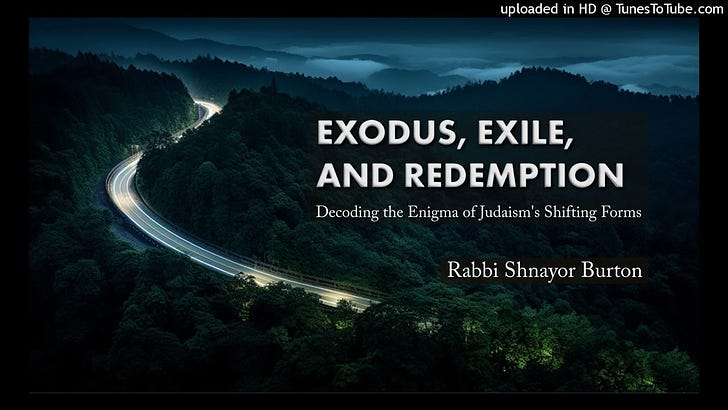EE & R, 1_3: The Problem of the History of Judaism: A Chronology of Judaism
← Prev | Table of Contents | Next →
1. The Problem of the History of Judaism – Judaism Across Time
The chronology outlined here is based on the Jewish tradition. Some of its details are debated; it is presented here in the form suited for this work.
The Exodus from Egypt took place in the year 1313 B.C.E, 2448 years after creation. The Tabernacle in which the Shechinah dwelt was erected first in the desert, then at various locations within the land of Israel. The First Temple was built 480 years after the Exodus, in 833 B.C.E. It stood for 410 years and was destroyed in the year 423 B.C.E. The Jewish nation was exiled to Babylon for 70 years, after which a minority returned to Israel and rebuilt the Temple, in the year 353 B.C.E.
Prophecy ceased forty years later, in the year 313 B.C.E.1 This same year is the first year of the dating system used in documents, which began when the Greek Empire spread across the world.2 Henceforth, documents were dated “In year x of the Greek Empire.”3
It emerges that prophecy ceased 1000 years after the Exodus from Egypt.4 For 1000 years, from 1313 to 313 B.C.E., the original Judaism prevailed, then to lapse.
The 1000-year epoch of divine revelation during which Hashem communicated with His people through prophets is associated with the Tabernacle and the First Temple. Upon their Exodus from slavery, Hashem commanded the Jewish people: “Let them make for Me a sanctuary, so that I will dwell in their midst” (Exodus 25:8). He promised that if His people would build Him a home, He would reside amongst them and communicate with them. They did as He had commanded them, and He did as He had promised: The Shechinah dwelt in their midst and granted them prophetic inspiration. Hashem dwelt in the homes built for His residence, first in the successive tabernacles and subsequently in the First Temple. The Second Temple, however, didn’t succeed in serving as a residence for Hashem. As a structure intended as an abode for Hashem, it was a failure. The Shechinah didn’t dwell in it;5 prophecy endured for the first forty years of the Second Temple Era only due to the lingering influence of the Shechinah that had dwelt in the First Temple.6
The critical moment when Judaism apparently came to its “end” is the year 1000 from the Exodus, which is the year 1 of the Greek Empire.
← Prev | Table of Contents | Next →
See Kuzari 3, 65: “Prophecy lasted for forty years during the Second Temple era”; Commentary on the Song of Songs, attributed to Ramban, 5:6: “Forty years after the rebuilding, visions were sealed.”
See Seder Olam Rabbah, 30: “That is Alexander of Macedonia who reigned for twelve years. Until then, prophets prophesied through the holy spirit, from now on – tilt your ear and listen to the words of the sages”; Rabbi Nissim Gaon, introduction to the Talmud: “…to the end of prophecy, which is the beginning of the reign of Alexander.”
See Talmud, Avodah Zarah, 10a.
See introduction to Sefer HaGalui: “Prophecy prevailed amongst our nation… 1000 years”; ibid., Second Gate: “When 1000 years passed from the gift of God, from the days of Moshe, man of God, to the completion of the rest of the prophets in the kingdom of Medea when visions were sealed, in the 40th year after the Temple was built by few people”; Sefer HaKabbalah, pg. 11: “That is the year 1000 from their leaving Egypt… and at that time… prophecy left Israel.”
See Talmud, Yoma 9b: “After the last prophets Haggai, Zechariah, and Malachi, died, the Divine Spirit departed from the Jewish people… the Shechinah would not have rested in the Second Temple.”
See Kuzari 3, 65: “Prophecy lasted for forty years during the Second Temple era, through those elders who had the assistance of the Shechinah from the First Temple.”



1,000 year age of prophecy... Presented so starkly it's hard not to be struck by how short a span that is in the grand scheme of history.